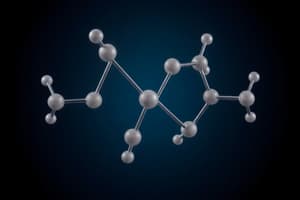Podcast
Questions and Answers
What does hybridisation primarily involve in atoms?
What does hybridisation primarily involve in atoms?
- The addition of electrons to the nucleus
- The splitting of electrons among orbitals
- The mixing of atomic orbitals (correct)
- The retention of individual atomic orbitals
What is the bond angle in methane, CH4, as determined by VSEPR theory?
What is the bond angle in methane, CH4, as determined by VSEPR theory?
- 120°
- 104.5°
- 90°
- 109.5° (correct)
Which hybridisation form allows carbon to form four C-H bonds in methane?
Which hybridisation form allows carbon to form four C-H bonds in methane?
- sp
- sp2
- sp3 (correct)
- p
Why is the bonding geometry in CH4 not based solely on the promotion of electrons?
Why is the bonding geometry in CH4 not based solely on the promotion of electrons?
Which statement about CH2 is true?
Which statement about CH2 is true?
Which atomic orbitals are involved in the hybridisation process for carbon in CH4?
Which atomic orbitals are involved in the hybridisation process for carbon in CH4?
What affects the geometric arrangement of electron pairs in VSEPR theory?
What affects the geometric arrangement of electron pairs in VSEPR theory?
What happens to the orbitals of carbon when it forms four bonds in CH4?
What happens to the orbitals of carbon when it forms four bonds in CH4?
What is indicated when three of the HCH bond angles are 90° based on orbital configuration?
What is indicated when three of the HCH bond angles are 90° based on orbital configuration?
What is the main principle of VSEPR theory?
What is the main principle of VSEPR theory?
Flashcards are hidden until you start studying
Study Notes
Hybrid Orbitals
- Hybridisation involves the mixing of atomic orbitals in a central atom to create hybrid orbitals used for covalent bonding.
- Hybrid orbitals result from the combination of two or more non-equivalent orbitals of the same atom.
- Overlapping atomic orbitals, sharing a common space, is essential for bonding concepts in polyatomic molecules.
Methane (CH4) Example
- Carbon's valence electron configuration is represented as 2s² 2p², showing two unpaired electrons in the 2p orbitals.
- In its ground state, carbon can only form two bonds with hydrogen, exemplified by the unstable CH2 molecule.
- To form four C-H bonds in methane, an electron is promoted from the 2s to one of the 2p orbitals, resulting in four unpaired electrons.
Molecular Geometry and VSEPR Model
- Despite having four unpaired electrons, the initial hybridisation model suggests incorrect bond angles of 90° due to the positioning of the 2p orbitals.
- Experimental results indicate that the actual H-C-H bond angles in methane are 109.5°.
- The Valence-Shell Electron Pair Repulsion (VSEPR) model explains the molecular geometry based on repulsion between electron pairs around a central atom.
Studying That Suits You
Use AI to generate personalized quizzes and flashcards to suit your learning preferences.



